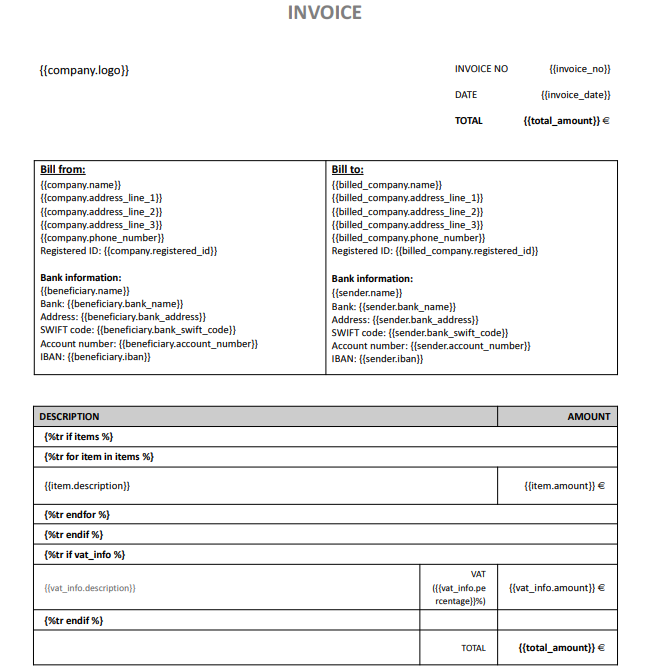 Backend Development
Backend Development
 Python Tutorial
Python Tutorial
 Automating Word Document Creation with Python and FastAPI (Using python-docx-template)
Automating Word Document Creation with Python and FastAPI (Using python-docx-template)
Automating Word Document Creation with Python and FastAPI (Using python-docx-template)
Jan 08, 2025 am 07:13 AM
Need to create Word documents with dynamic content and automate the process? Python, with the python-docx-template library, offers an efficient solution. This tutorial demonstrates how to dynamically generate Word documents, eliminating the need for manual updates.
Let's illustrate with an invoice example. Manually updating invoice data is tedious and impractical when dealing with data from APIs. Dynamic generation solves this.
Consider a Word document template:

Company details and item lists frequently change. Dynamic generation handles this variability.
To achieve this, modify the template for Jinja2 compatibility. Jinja2's templating features (conditional rendering, looping) enable dynamic population based on provided data.
- Learn more about Jinja2: https://www.php.cn/link/7ef6c2494e3925e414c7730d6455b50f
The Jinja2-compatible template looks like this:

Jinja2 syntax (e.g., {% if %} and {% for %}) might seem initially complex, but it provides powerful control. Expressions within {{ }} represent variables populated at runtime. For instance, {% if items %} checks if the items variable exists before rendering table rows. {% for item in items %} iterates through the items list, generating a row for each item.
- Learn more about Jinja2 tags: https://www.php.cn/link/a3a8185b610d2c5e39015f64972c8705 and https://www.php.cn/link/7ef6c2494e3925e414c7730d6455b50f
Now, let's create a FastAPI server to render the template using Python.
-
Create a virtual environment:
pip3 install virtualenv virtualenv -p python3 venv source venv/bin/activate
Copy after loginCopy after login -
Install libraries:
pip install "fastapi[standard]" docx docxtpl pydantic requests
Copy after login -
Create
main.py: Start with a basic FastAPI endpoint:from fastapi import FastAPI app = FastAPI() @app.get("/") def read_root(): return {"Hello": "World"}Copy after loginAccessing
localhost:8000should return{"Hello": "World"}. -
Import the Jinja2 template: Place your modified
invoice_tpl.docxin the project root. -
Enhance
main.py: The following code handles the template rendering, image fetching, and total amount calculation:pip3 install virtualenv virtualenv -p python3 venv source venv/bin/activate
Copy after loginCopy after login -
Test the endpoint: Send a JSON payload (similar to the example in the original text) to the
/endpoint. -
Output examples: (Images from the original text would be included here)
Conclusion: This tutorial demonstrates dynamic Word document generation using python-docx-template and FastAPI. The combination of Jinja2 and FastAPI creates a flexible system for automating document creation. A future blog post (Part 2) will cover PDF generation.
Repository: https://www.php.cn/link/1df146af0948a68b1342ce39907668fe
Follow Husein Kantarci:
- Personal portfolio: huseink.dev
- LinkedIn: https://www.php.cn/link/50de294b9d4987a3c89b4a5cc4bdea62
- GitHub: https://www.php.cn/link/f2f9990bcda13be8771d656bf489dad5
- GitLab: https://www.php.cn/link/33bd1b801b3cf1b8eaf31d816bca2c95
Remember to replace the placeholder image URLs with actual image URLs. The code also assumes you have the necessary data models defined (Company, BankInformation, Item, VatInformation, InvoiceContext) as in the original example.
The above is the detailed content of Automating Word Document Creation with Python and FastAPI (Using python-docx-template). For more information, please follow other related articles on the PHP Chinese website!

Hot Article

Hot tools Tags

Hot Article

Hot Article Tags

Notepad++7.3.1
Easy-to-use and free code editor

SublimeText3 Chinese version
Chinese version, very easy to use

Zend Studio 13.0.1
Powerful PHP integrated development environment

Dreamweaver CS6
Visual web development tools

SublimeText3 Mac version
God-level code editing software (SublimeText3)

Hot Topics
 How Do I Use Beautiful Soup to Parse HTML?
Mar 10, 2025 pm 06:54 PM
How Do I Use Beautiful Soup to Parse HTML?
Mar 10, 2025 pm 06:54 PM
How Do I Use Beautiful Soup to Parse HTML?
 How to Use Python to Find the Zipf Distribution of a Text File
Mar 05, 2025 am 09:58 AM
How to Use Python to Find the Zipf Distribution of a Text File
Mar 05, 2025 am 09:58 AM
How to Use Python to Find the Zipf Distribution of a Text File
 How to Perform Deep Learning with TensorFlow or PyTorch?
Mar 10, 2025 pm 06:52 PM
How to Perform Deep Learning with TensorFlow or PyTorch?
Mar 10, 2025 pm 06:52 PM
How to Perform Deep Learning with TensorFlow or PyTorch?
 Introduction to Parallel and Concurrent Programming in Python
Mar 03, 2025 am 10:32 AM
Introduction to Parallel and Concurrent Programming in Python
Mar 03, 2025 am 10:32 AM
Introduction to Parallel and Concurrent Programming in Python
 Serialization and Deserialization of Python Objects: Part 1
Mar 08, 2025 am 09:39 AM
Serialization and Deserialization of Python Objects: Part 1
Mar 08, 2025 am 09:39 AM
Serialization and Deserialization of Python Objects: Part 1
 How to Implement Your Own Data Structure in Python
Mar 03, 2025 am 09:28 AM
How to Implement Your Own Data Structure in Python
Mar 03, 2025 am 09:28 AM
How to Implement Your Own Data Structure in Python
 Mathematical Modules in Python: Statistics
Mar 09, 2025 am 11:40 AM
Mathematical Modules in Python: Statistics
Mar 09, 2025 am 11:40 AM
Mathematical Modules in Python: Statistics







